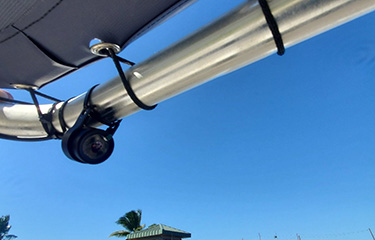Net Gains Alliances makes case for fishermen to adopt electronic monitoring

The Net Gains Alliance (NGA) has released recommendations for an electronic monitoring program designed to advance data modernization in the U.S. seafood industry.
Contained in the report, “Recommendations for electronic monitoring program design and requests for proposal,” NGA’s effort was focused on defining fishery monitoring objectives and evaluating a full suite of tools and approaches to best achieve those goals. The effort centered around ensuring the inclusion of the fishing industry in the program’s design process and in meetings and consultations with electronic monitoring (EM) equipment and service providers, according to California Environmental Associates Consulting Lead Technical Consultant Mark Michelin, who helped develop the program under the leadership of NGA and Council Fire – a sustainability-focused consultancy – and backed with funding from the Walton Family Foundation and the Packard Foundation.
“If you think about the marketplace now, you can divide it simply into two types of EM programs: one is industry-led and one is regulatory-led,” Michelin said. “Industry-led ones see a particular value in the data coming from the EM program and [companies] want to use that as a tool to improve their business. Whether it’s opening markets to specific customers or dealing with particular challenges they as an industry are having on the water. Regulatory-led ones are usually ones that come from a regulator that is looking for monitoring [science] or compliance on the water. In these programs, a mandate comes down to install EM on vessels. From an individual vessel perspective, there can be benefits in both types of programs. EM programs and data analysis cost money, but the data that comes off of them and how it is used can create business opportunities.”
This report was formed through collaboration between a group of EM providers keen to speed up EM uptake and Annapolis, Maryland, U.S.A.-headquartered NGA, a global initiative focused on ensuring the sustainable management of global fisheries which has been working on data modernization in the seafood industry since its establishment in 2017. Council Fire, a sustainability-focused consultancy also based in Annapolis, originally designed and launched the NGA.
“The aim was to create a functional alliance made up of a team of people that are working towards driving NOAA to articulate and adopt policies for improving data management and information systems to enhance fisheries management in the U.S., with the end result being enhancing the economic, social, and environmental outcomes of better fisheries management for fishermen, for the natural resource, for communities, state managers, national managers, all of that,” Council Fire Principal Consultant Jonathan Webster said.
For fishermen, the incentive for participation is economic: higher quotas and better yields as a result of more-accurate data, Webster said.
“There is a very real and near-term economic benefit for fishermen,” Webster said. “A huge factor for the industry is more-effective collection and analyzation of data in real time to allow fishery management decisions to be dynamic, with regular updates, and not based on stock assessments that are 12 to 24 months old. Most of the time, stocks assessments are done in ways that are more conservative, which results in leaving fish in the water. Ultimately, there is an economic incentive, if there is a higher level of transparency in terms of what is being caught, and it is available to be reviewed and analyzed in real-time – it enables fisheries managers to make decisions with an overwhelming majority of the time resulting in the fishermen actually being able to harvest more and able to plan much better.”
Webster said there’s a sustainability link to improving how electronic monitoring actually works on the water.
“It’s not just all about taking more. It’s also about other changing factors, such as climate change shifting different stocks, so real-time data rapidly impacts manager decisions to make more-effective choices that’ll be better for fishermen and stocks,” he said.
To show how an effective EM system looks in practice and the benefits it can have, NGA funded the creation of the Western Alaska Data Portal for the Western Gulf of Alaska fleet. The fleet, organized under the banner of the Peninsula Fishermen’s Coalition, fishes out of three ports in the Aleutians East Borough of Alaska: King Cove, Sand Point, and False Pass. For the fleet, the data portal became necessary as a means of solving a longstanding issue it had with chinook salmon bycatch. Once the hard-cap limit for chinook has been reached, the fleet’s pollock fishery must be closed, making the exact and timely count of salmon paramount to maximizing the fleet’s catch.
The electronic monitoring system created for the fishery – soon to enter full-scale trials – included a map showing chinook hot spots capable of being updated in near real-time. The portal also allows timely access to submitted fish tickets and the ability for vessel owners and operates to view their own confidential data through an individual login. And the data can be used to create detailed reports from all EM-reviewed trips.
“The goal of the portal was to make it fishermen-owned and fishermen-driven, so they have control over their data. We consulted with them during the whole process to get data on what they wanted to see and how it would be useful to them,” Aleutians East Borough Natural Resources Assistant Director Charlotte Levy said. “Generally, we’re part of a bigger movement to shift the way we look at data and the way we collect data. I think part of the beauty of this project is that even though the project is very specific to our region and our problem, there is this bigger benefit to show management and other fisheries it’s possible to rethink how we own data, share it, and use it.”
Michelin said creating the portal provided NGA an opportunity to determine the issues it might face in creating similar EM-based systems for other fleets, particularly around technology and data collection and the legal aspects of how the data is used, stored, who has access, and who owns it. He said many of its findings are included in NGA’s new report.
“The main output of the collaboration was the guidance on request for proposals of EM programs,” Michelin said. “The goal of the report is to provide guidance to customers on all the things you need to consider when thinking about how to select an EM provider or how to design an EM program. Basically, it is trying to get people up to speed on EM systems and programs quicker and easier, so they have a more informed view of what they need to look for.”
Webster said he understands the reluctance – and even hostility – of many fishermen to EM technology. But he said fishermen have more to gain from putting their stamp on EM solutions than ignoring them.
“Traditionally, there has been hesitancy from fishermen and the fishing industry, as in many places, it is old and rooted in tradition. There is this sense of, ‘I don’t want to share with anyone where I’m catching what I’m catching,’ and a sense of pride and independence from the fishermen,” Webster said. “A lot of the inherent skills and attributes that enable them to be successful, enduring fishermen are the same sort of traits that make them question monitoring and government.”
Webster urged fishermen and members of the seafood industry try to overcome that hesitance to take the opportunity to ensure their voice is included in the process of modernizing the fishing industry, which Webster described as an inevitability.
“Things are changing,” he said. “You’ve already got observers on board, so whether that is human or counted in another way matters less. The technology is already changing how fisheries management works and largely that’s been for the better. We need to embrace it and understand if we get on board and are active in how this is done, then we benefit.”
Photo courtesy of Net Gains Alliance






Share